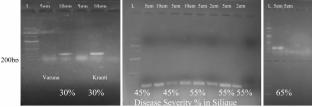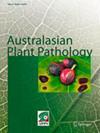Insights into silique to seed infection, survival in seed and PCR based detection threshold establishment of Alternaria brassicae in the Indian mustard seeds
Abstract
A. brassicae (Berk) Sacc. is an important necrotrophic fungal pathogen causing black leaf spot disease in crucifers. Seed can serve as a potential source of inoculum for the transmission of A. brassicae in mustard; however, silique -to-seed transmission of pathogen, the favoring environmental conditions along with the detection threshold for seed were not characterized empirically. So, the objectives of this study were to (i) determine the effect of environmental variables in disease appearance in field conditions in correlation with impact on yield, for this purpose mustard seeds were sown on different sowing date starting from 1st Oct to 19th Nov. at weekly interval; (ii) evaluate the effect of natural silique infection on silique-to-seed transmission of A. brassicae, for this purpose the seeds collected from naturally infected silique were analysed for pathogen recovery (iii) implications of the survival of A. brassicae in stored seeds at different temperature, for this purpose the collected mustard seeds were stored at varied temperature ranges; (iv) evaluate the detection threshold in stored seeds before next sowing season through PCR. The results indicate that development of Alternaria blight was favored by a mean maximum and minimum temperature between 29.0 and 20.9 °C and 11.3 to 6.9 °C respectively with an average relative humidity of more than 80% leading to earliest appearance of symptom in 98 days after sowing (DAS). A silique to seed transmission of approximately 42.6% was recorded for A. brassicae in the seeds collected from silique lot showing 65% disease severity. The stored seeds were monthly checked for pathogen recovery till six months and pathogen recovery of 19.6% and 13.8% was observed in stored seeds in Sep’24(before sowing) at 10ºC and 20ºC respectively while there was no recovery of pathogen in seeds stored at room temperature in Agar plate method. A specific fragment of ~ 400 bp was amplified by PCR using the specific primers and detection limit of 10gm seed at 30.00% silique infestation level and of 1gm at 65.00% silique infestation level was observed in stored seeds.


 求助内容:
求助内容: 应助结果提醒方式:
应助结果提醒方式:


